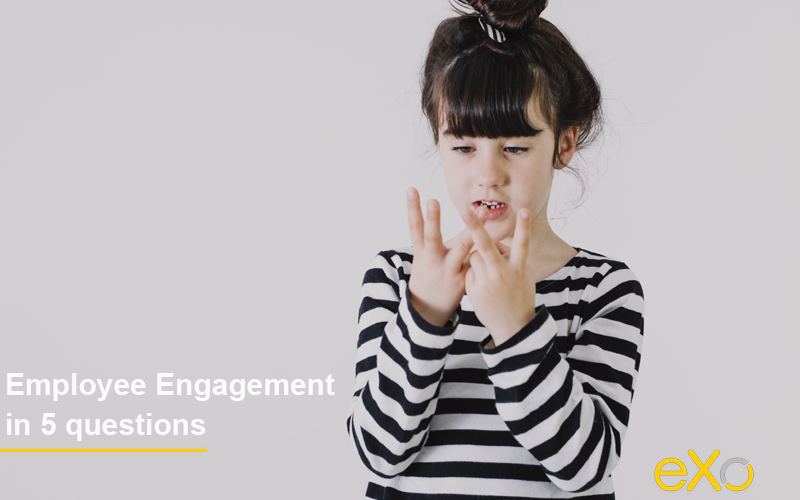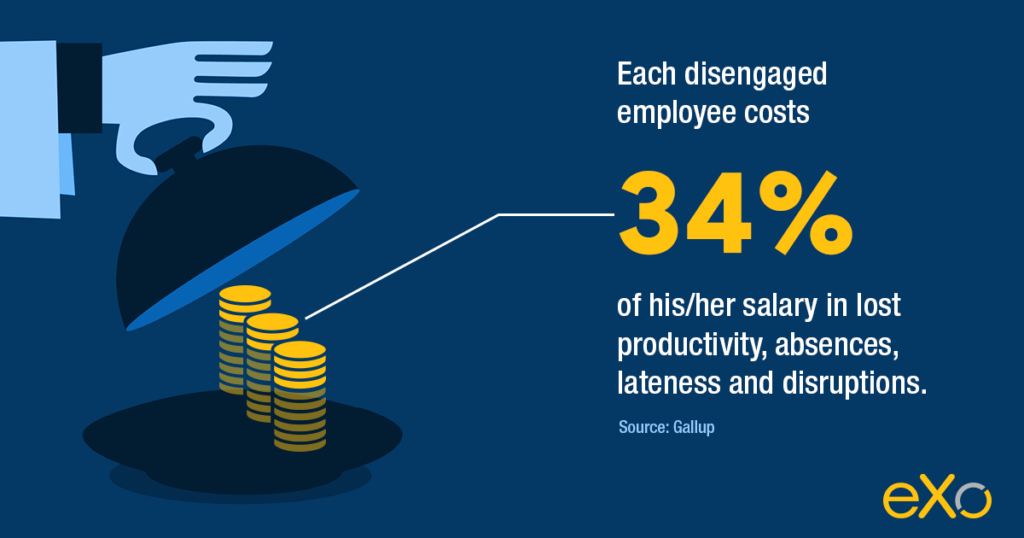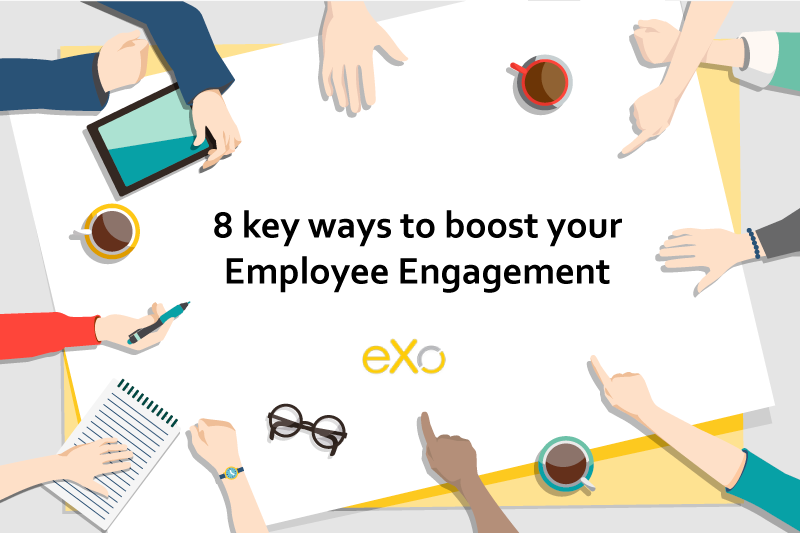Five questions covering everything you need to know about employee engagement

Content
1. What is employee engagement?
There are many definitions for the concept of employee engagement out there. For instance, Wikipedia defines employee engagement as a ‘fundamental concept in the effort to understand and describe, both qualitatively and quantitatively, the nature of the relationship between an organization and its employees’.
The concept is easier to understand when applied to a person. Engaged employees get motivated by their jobs, feel positively about their organizations, and go the extra mile to promote the organization’s interests even outside office hours.
In comparison, disengaged employees feel no particular attachment to their companies and do as little as possible at work, approaching it purely as a means to earn a paycheck.
In practice, disengaged employees would work less and less well. They would take all the sick days possible, arrive as late as possible and leave as early as possible, complete the minimum required tasks with minimum required quality and never make an extra effort to promote the company.
Needless to say, organizations full of engaged employees outperform those full of indifferent workers.
2. Employee engagement, employee satisfaction, employee experience: Are they all the same?
Although employee engagement, satisfaction and experience are often used interchangeably, they are not synonyms.
Satisfied employees are happy with their overall job conditions, mainly compensation and the workplace.
However, that does not necessarily mean an employee is engaged. Take an average office worker who does not really see the meaning of his job or adhere to his company values but who likes his colleagues, his status and his paycheck. He puts the time into his job but doesn’t show any enthusiasm.
If job satisfaction is often seen as a first step to engagement, an employee can be engaged and dissatisfied in rare instances, e.g. when payroll or office conditions temporarily deteriorate.
Employee experience is used to encompass every interaction an employee has with a company throughout her employment.
Inspired by customer experience marketing, employee experience is often used as a primary strategy to boost employee satisfaction and employee engagement through a better, more comprehensive approach to employees.

FREE WHITE PAPER
The Complete
Guide to
Employee Engagement
Guide to
Employee Engagement
There are many definitions for the concept of employee engagement out there.
3. Why is employee engagement such a hot topic today?
Employee engagement is a fairly new concept that William A. Kahn first mentioned in 1990 in the Academy of Management Journal. By 2000, Gallup refined its survey to include employee engagement-related questions, gradually assembling a thorough database of factors that influence engagement at work.
In 2018, ‘employee engagement’ was used as a search term on Google 401,100 times, showing the concept’s popularity.
In a recent SHRM/Globoforce study, 39% of the HR employees surveyed considered employee engagement the most important challenge for their organisation.
So why has employee engagement become such a trend over the last 20 years?
First, we are facing an increasingly tense global job market. The Baby Boomer generation, which is larger than Generation X and Millennials, is retiring, creating a gap in the workforce.
Thus, the age of the working population will halve by 2040 (BCG) in the United States alone. This demographic phenomenon has led to a global labor shortage as the workforce relocates and competition between employers increases to vie for available talent while considering the average moving costs they would go through to relocate to the main site.
Furthermore, Millennials reached their 20s around 2000. Millennials already represent the largest generation in the workplace, and by the time the job crisis hits its peak in 2030, Millennials will comprise 75% of the workforce.
In addition, millennials are different. In fact, they are so different that hundreds of articles, videos and research studies have examined their characteristics. The word ‘millennial’ was googled 18,660,000 times in 2018.
Millennials have different expectations regarding the workplace, including flexibility, an ability to search for meaning, and personal development.
They are accustomed to instant gratification, e.g. instant access to information. They focus on experience as opposed to possessions in all their choices, which leads them to look for an optimum employee experience rather than sacrificing the now for a brighter cash-driven future.
Finally, as employee engagement in the workplace gets more attention, more evidence supports the correlation and cause-and-effect relationship between engagement and a company’s business performance.
4. Are your employees disengaged? Probably
Have you already measured employee engagement within your company? How do you think it compares to that of your peers and competitors?
Average statistics on employee engagement are low. According to Gallup, the level of employee engagement is now 34% in the United States, which is the best-performing county in this area.
After years of stagnation with levels under 30%, rates just picked up in 2018. In comparison, less than 10% of employees in France say they are actively engaged in their companies.
Therefore, unless you measured your engagement and obtained good results, chances are that at least two-thirds of your employees are disengaged.
5. How much does it cost you? Would better employee engagement really make a difference?
Gallup estimates that each disengaged employee costs you 34% of his or her salary in lost productivity, absences, lateness and disruptions. That does not include the lost opportunities of employing an outperforming, engaged employee.

On the contrary, studies have shown positive correlations between employee engagement levels and business performance.
According to the Harvard Business Review, companies with engaged employees are 12% more profitable than average, and highly engaged business units outperform disengaged ones by 21%.
eXo Platform 6 Free Datasheet
Download the eXo Platform 6 Datasheet and
discover all the features and benefits
discover all the features and benefits
FAQs
What is employee engagement?
It’s the willingness of an employee to help his company progress. It is a positive behavior, which manifests itself by a strong involvement in his work and by a great motivation. This allows the company to evolve both in terms of its activity and on a human level.
How to Improve Employee Engagement in the Workplace?
- Ensure a strong corporate culture
- Ensure good relationship with management
- Foster good relationships between the colleagues
- Think about employee recognition
- Express meaning for work in your organization
- Make well-being and work/life balance your priority
- Allow more flexibility and autonomy
- Invest in skills development and training
➝ Find out how to improve employee engagement in the workplace
4.5/5 - (6 votes)
I am the Chief Executive Officer of eXo Platform (the open source digital workplace platform), a company that I co-founded while in college and that I came back to after several years in the banking and consulting industry. I blog about modern work, about open-source and sovereignty issues. Occasionally, I also blog about my personal areas of interest, such as personal development, work–life balance, sustainability and gender equality.
Related posts
- All
- eXo
- Digital workplace
- Open source
- Internal communication
- Collaboration
- News
- intranet
- Future of work
- workplace
- Knowledge management
- Employee engagement
- Employee experience
- Employee productivity
- onboarding
- Employee recognition
- Change management
- Cartoon
- Digital transformation
- Infographic
- Remote work
- Sneak Peek
- Solutions
- Thought leadership
- Tips & Tricks
- Tutorial
- Uncategorized
Leave a Reply
( Your e-mail address will not be published)
Connexion
0 Comments
Commentaires en ligne
Afficher tous les commentaires


